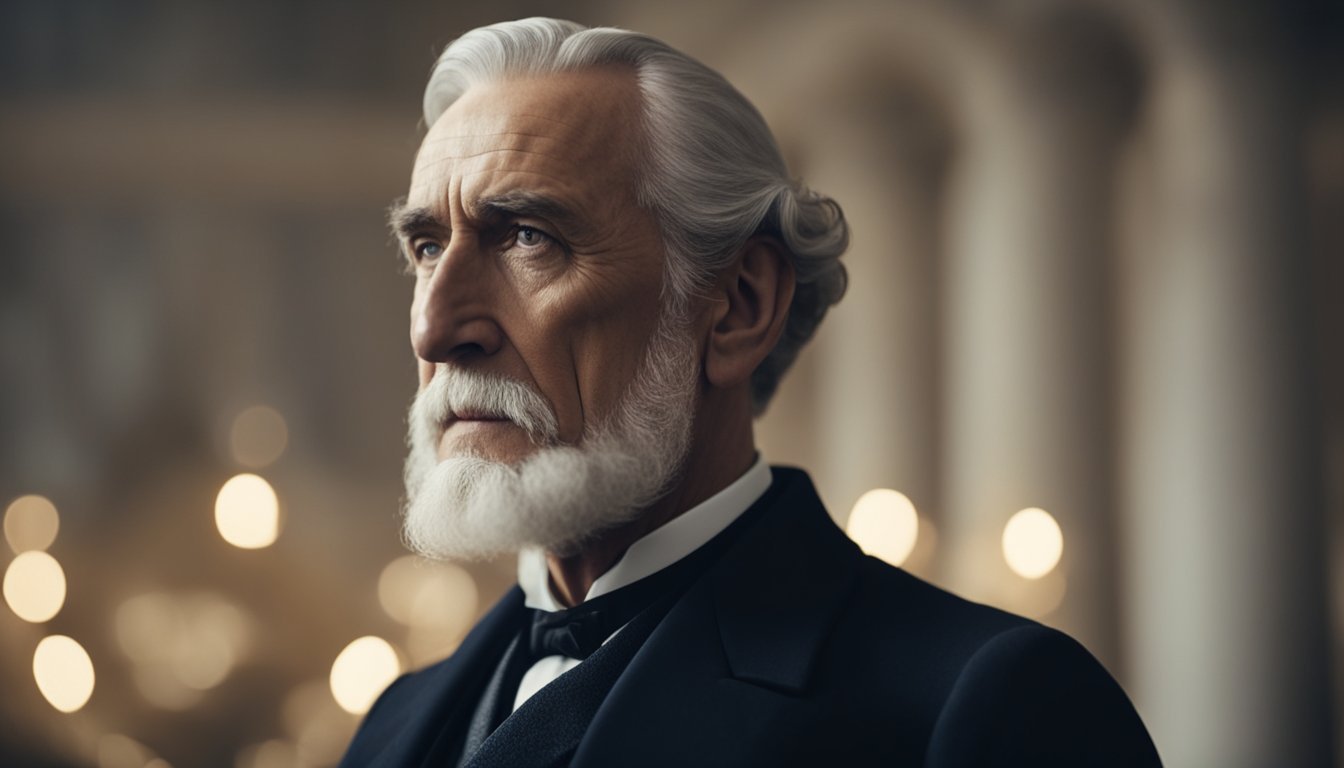6 Compelling Films on Calvin Coolidge's "Silent Cal" Presidency
Exploring the Legacy of America's 30th President
Calvin Coolidge, the 30th President of the United States, earned the nickname "Silent Cal" due to his reserved demeanor and economical use of words. Despite his quiet nature, Coolidge's presidency from 1923 to 1929 was marked by significant events and policies that shaped America during the Roaring Twenties.
Films exploring Coolidge's presidency offer unique insights into his leadership style, political philosophy, and the challenges he faced during his time in office. These cinematic portrayals provide viewers with a deeper understanding of Coolidge's character and the impact of his administration on American history. From his advocacy for fiscal responsibility to his utilization of new media like radio, these films shed light on the complexities of Silent Cal's tenure in the White House.
1) "Silent Cal: The Quiet President" by Ken Burns (2022)
Ken Burns, renowned for his historical documentaries, brings Calvin Coolidge's presidency to life in "Silent Cal: The Quiet President." This compelling film explores the complexities of Coolidge's character and his impact on American politics during the Roaring Twenties.
Burns skillfully weaves together archival footage, photographs, and expert interviews to paint a nuanced portrait of the 30th President. The documentary delves into Coolidge's early life in Vermont and his rise through the political ranks.
The film examines Coolidge's governing style, highlighting his commitment to limited government and fiscal conservatism. It also sheds light on his relationship with his wife Grace and the tragic loss of their son Calvin Jr.
"Silent Cal" offers a balanced view of Coolidge's presidency, discussing both his successes and criticisms. Burns' trademark storytelling brings a fresh perspective to this often-overlooked period in American history.
More information on "Silent Cal: The Quiet President" by Ken Burns
2) "Coolidge Presidency: A Silent Triumph" by PBS (2008)
PBS produced this insightful documentary exploring Calvin Coolidge's presidency. The film sheds light on Coolidge's leadership style and policy decisions during the Roaring Twenties.
Narrated by historians and political experts, "A Silent Triumph" examines Coolidge's commitment to limited government and fiscal conservatism. It highlights his efforts to reduce the national debt and cut taxes while maintaining economic prosperity.
The documentary delves into Coolidge's reputation as "Silent Cal" and how his reserved demeanor shaped his public image. It also explores his relationship with the press and his pioneering use of radio addresses to connect with the American people.
"A Silent Triumph" offers a balanced perspective on Coolidge's legacy, discussing both his successes and the criticisms of his hands-off approach to governing. The film provides valuable context for understanding this often-overlooked period in American history.
Learn more about the PBS documentary on Calvin Coolidge
3) "Leadership of Silence: The Coolidge Era" by History Channel (2016)
"Leadership of Silence: The Coolidge Era" offers a comprehensive look at Calvin Coolidge's presidency. This History Channel production explores Coolidge's unique leadership style and its impact on 1920s America.
The film delves into Coolidge's reputation as "Silent Cal" and how he used this persona to his advantage. It examines his economic policies, including tax cuts and reduced government spending, which contributed to the prosperity of the Roaring Twenties.
Viewers gain insight into Coolidge's personal life, including his rural upbringing in Vermont and the tragic loss of his son while in office. The documentary also covers key events of his presidency, such as the Kellogg-Briand Pact and his decision not to seek re-election in 1928.
Through interviews with historians and archival footage, the film provides a balanced portrayal of Coolidge's strengths and limitations as a leader. It sheds light on his belief in limited government and his cautious approach to foreign policy.
More information on "Leadership of Silence: The Coolidge Era"
4) "The Quiet Force: Calvin Coolidge" by Smithsonian Channel (2016)
"The Quiet Force: Calvin Coolidge" offers a comprehensive look at the 30th President of the United States. This Smithsonian Channel documentary explores Coolidge's rise to power and his impact on American politics during the 1920s.
The film delves into Coolidge's background, from his humble beginnings in Vermont to his ascent to the presidency. It examines his reputation as "Silent Cal" and how this persona shaped his leadership style.
Experts and historians provide insights into Coolidge's policies and their effects on the nation's economy. The documentary also touches on his personal life, including his relationship with his wife Grace and the tragic loss of their son.
Through archival footage and photographs, viewers gain a visual understanding of the era in which Coolidge governed. The film presents a balanced view of his presidency, discussing both his successes and criticisms.
"The Quiet Force" sheds light on Coolidge's legacy and his influence on modern conservative politics. It serves as an informative resource for those interested in this often-overlooked president and his era.
More information on "The Quiet Force: Calvin Coolidge"
5) "Behind the Calm: Coolidge's Silent Strength" by National Geographic (2022)
National Geographic's documentary offers a nuanced look at Calvin Coolidge's presidency. The film explores how Coolidge's reserved demeanor belied his political acumen and leadership skills.
Interviews with historians provide context for Coolidge's economic policies and their impact on 1920s America. Archival footage and photographs bring the era to life, showcasing the contrast between Coolidge's quiet persona and the vibrant "Roaring Twenties."
The documentary delves into Coolidge's personal life, including his relationship with his wife Grace and the tragic loss of their son. These intimate details offer insight into the man behind the presidential facade.
"Behind the Calm" also examines Coolidge's stance on civil rights and his interactions with Native American tribes. The film presents a balanced view of his presidency, acknowledging both his successes and shortcomings.
More information about the film
6) "Coolidge: The Silent Legacy" by American Experience (2004)
"Coolidge: The Silent Legacy" offers a comprehensive look at Calvin Coolidge's presidency. This documentary, produced by American Experience, explores the life and political career of the 30th U.S. President.
The film delves into Coolidge's rise from a small-town lawyer to the highest office in the land. It examines his conservative fiscal policies and his hands-off approach to governing during the Roaring Twenties.
Interviews with historians and archival footage provide insights into Coolidge's personality and leadership style. The documentary also addresses the challenges he faced, including the aftermath of the Teapot Dome scandal.
"The Silent Legacy" highlights Coolidge's economic policies and their impact on the prosperity of the 1920s. It discusses his tax cuts and reduced government spending, which contributed to a booming economy.
The film presents a balanced view of Coolidge's presidency, acknowledging both his successes and criticisms. It offers viewers a deeper understanding of this often overlooked figure in American history.
More information on "Coolidge: The Silent Legacy"
Overview of Calvin Coolidge's Presidency
Calvin Coolidge ascended to the presidency in 1923 following Warren Harding's death. Known as "Silent Cal" for his reticence, Coolidge's tenure was marked by economic prosperity and conservative policies.
Political Landscape
Coolidge's presidency emerged during the "Roaring Twenties," a period of social and cultural dynamism. He easily secured the Republican nomination in 1924, winning the election with a comfortable margin. His administration prioritized limited government intervention and fiscal responsibility.
Coolidge faced challenges from progressive Republicans and Democrats who sought more active federal involvement. He successfully vetoed several bills that he deemed excessive, including agricultural subsidies. His hands-off approach to governance aligned with the prevailing mood of the business community.
Economic Policies
Coolidge championed tax cuts and reduced government spending. He worked closely with Treasury Secretary Andrew Mellon to implement significant reductions in income tax rates. These cuts primarily benefited wealthier Americans and businesses.
The president promoted a pro-business environment, believing that economic growth would benefit all citizens. His policies contributed to the decade's economic boom, with rising stock prices and increased consumer spending.
Coolidge's administration saw a budget surplus each year, which he used to pay down the national debt. He resisted calls for farm relief and refused to intervene in labor disputes, adhering to his laissez-faire philosophy.
Cultural Impact of the 'Silent Cal' Era
Calvin Coolidge's presidency left a lasting mark on American culture. His reserved demeanor and economic policies shaped public perception and influenced media portrayals for decades.
Media Representations
Silent films and early talkies often depicted Coolidge as a laconic figure. Political cartoonists frequently portrayed him as stoic and tight-lipped. Radio broadcasts of his speeches introduced audiences to his distinctive New England accent.
The 1924 election saw campaign films promoting Coolidge's image as a steady, frugal leader. Newsreels captured his public appearances, reinforcing his reputation for brevity.
In later years, TV shows and movies referenced "Silent Cal" as shorthand for reticence. Comedians occasionally impersonated Coolidge, exaggerating his taciturn nature for laughs.
Public Perception
Coolidge's nickname "Silent Cal" became deeply ingrained in the public consciousness. Many Americans viewed his reserved manner as a sign of wisdom and careful deliberation.
His fiscal conservatism resonated with those who favored limited government. Some saw Coolidge as a model of personal restraint and traditional values.
Critics, however, interpreted his reticence as detachment or lack of leadership. The Great Depression later led some to question his economic policies.
Coolidge's emphasis on hard work and thrift aligned with popular notions of the "American Dream." His simple lifestyle in the White House contrasted with the excesses of the Roaring Twenties.
Filmmaking Techniques in Political Cinema
Political films employ specific techniques to portray historical events and figures accurately while crafting engaging narratives. These methods balance authenticity with storytelling to create impactful cinematic experiences.
Authenticity and Historical Accuracy
Filmmakers meticulously research period details to recreate the look and feel of past eras. Set designers construct authentic environments, while costume designers craft historically accurate wardrobes. Makeup artists transform actors to resemble real political figures.
Dialogue often incorporates actual quotes and speeches. Archival footage may be seamlessly integrated to enhance realism. Consultants with expertise in the time period or specific events are frequently brought on to ensure accuracy.
Cinematographers use lighting and camera techniques to evoke the visual style of the era being portrayed. This attention to detail helps immerse viewers in the historical setting.
Narrative Structure
Political films often employ nonlinear storytelling to highlight key moments in a leader's career. Flashbacks and flash-forwards create connections between past events and their consequences.
Voiceover narration provides context and insight into characters' thoughts. This technique can effectively convey complex political ideas or historical background.
Parallel storylines may be used to contrast the public and private lives of political figures. This approach adds depth to characterizations and explores the personal toll of public service.
Montages compress time to show the progression of political campaigns or policy implementation. These sequences efficiently convey the passage of time and changing political landscapes.





